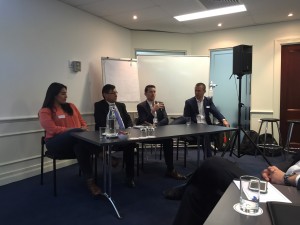We may be on the other side of the world, but we’re all in the same boat.
 That was my biggest take-away from this year’s annual ROI Summit series in Singapore and Sydney. Over 150 technology marketers from APJ packed the room to learn about the most common digital marketing mistakes (and how to avoid them). We also had an in-depth discussion of the technology buyer journey (both from a digital perspective and from interviews with real technology buyers).
That was my biggest take-away from this year’s annual ROI Summit series in Singapore and Sydney. Over 150 technology marketers from APJ packed the room to learn about the most common digital marketing mistakes (and how to avoid them). We also had an in-depth discussion of the technology buyer journey (both from a digital perspective and from interviews with real technology buyers).
This year’s APAC ROI summits were also full of content from local marketing experts, including a session from Ben Johnson, SAP’s Senior Manager of Digital Marketing, and two senior marketer panel discussions with experts from SAS, SAP, RackSpace, Intel, EMC and Alpha7. As someone who’s attending ROI Summits in the US, UK and now APJ, I was surprised by how universal and common some global technology marketing challenges have become. There were three issues that dominated at this year’s events.
Challenge #1: How do we work better with sales?
 This came up in both panel discussions, as well as Ben Johnson’s presentation. The bottom line from all our experts was that this is not easy and not something that is typically going to happen on its own. It takes time, effort and a serious commitment from both sides for it to work. I believe one of our experts summed it up perfectly. “In order for my team to succeed we need them, but in the new world of the educated buyer, they need us too.”
This came up in both panel discussions, as well as Ben Johnson’s presentation. The bottom line from all our experts was that this is not easy and not something that is typically going to happen on its own. It takes time, effort and a serious commitment from both sides for it to work. I believe one of our experts summed it up perfectly. “In order for my team to succeed we need them, but in the new world of the educated buyer, they need us too.”
- Many of our experts agreed that the TechTarget IT Deal Alert Qualified Sales Opportunity program has been a good way to get meetings with the sales team and also show the value of always-on content marketing and influence. Being able to show sales early influence and contact discovery at organizations where a Qualified sales Opportunity now sits has opened their eyes to the value of digital marketing (at all buying stages).
Challenge #2: Our KPIs are sometimes forcing us to make poor decisions
As we all know, one of the main advantages of digital marketing is the ability to track and deliver results. In most cases results mean ROI – But how is marketing ROI defined? What we learned at the summits this year is that this can be different for every organization and sometimes every product line. The one shared pain was that everyone is now judged on it, and if anything the definition now sits closer to point of sale vs. the more traditional view of market/pipeline impact. Both expert panels expressed concern with sometimes having to purchase inferior media in order to support the new KPIs they were given. Here were some of the common issues we discussed.
- Tracking ROI: During the Sydney panel marketers from SAS, SAP and Rackspace all agreed that tracking results is one of their biggest challenges (even with very sophisticated systems in place). Even with sophisticated tools and algorithms, tracking marketing driven ROI still requires sales to tag “good” leads, which can often be overlooked. Successful ROI tracking required a lot of face time with sales and some hand holding. Weekly meetings with sales management has really helped identify marketing’s impact on their current (and future) pipeline and increased the overall perception of success.
- KPIs driven from the US without understanding local markets. During our question and answer session, both Singapore and Sydney marketers expressed concerns about where their KPIs are being set, especially if it’s coming from outside the region. Common complaints included US or Europe demanding local teams buy only programs with strict filters (sometimes in markets where they don’t make sense). For example, a 1000+ company size filter in Australia can severely limit the pool of companies they can target and the success of the program. Lack of understanding from corporate about local costs and CPLs/CPMs was also something many marketers expressed concerns with. Some marketers were even limited to just buying local events, even though sales wasn’t having success with them due to the extremely crowded event market in Asia. How did our panel address this? Get a seat at the table. All our experts expressed the need to work with management in other regions to define lead qualifications and goals. Without having some control over their goals they would be set up to fail.
Challenge #3: Content limitations
While some of the larger organizations like SAP and SAS seemed to have less of a concern about this, many of the marketers in the room expressed issues with content. As most represent regional field offices, they have smaller budgets for content creation and need to lean on other regions content. While US and European content still tends to perform very well in region, there are some issues.
- Lack of visibility into the new content that’s being created in the US. Communication between marketing teams in all regions, especially about new content that’s being created, is critical. Content is the fuel for running demand generation programs and it’s so important that all regions have access to everything that’s on the shelf.
- Lack of funding for local case studies and customer testimonials. In general, using US or European content will be successful across all English-speaking APAC countries, but there is still a need for local case studies. Many of the marketers in the room expressed concerns about the lack of budget they have for local content creation. They fill the gaps by using US or European case studies, but it does not have the same impact.
There was no way we were going to be able to solve all these challenges in a half-day, but everyone left with some fresh ideas and a revitalized sense of community. We would love to hear your ideas too – if you have any advice for marketers targeting these regions, please leave a comment below.
Global technology marketing challenges image via Shutterstock




